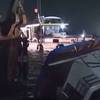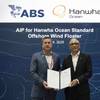Senator Warner: Tech from Dahlgren Impacts Tomorrow’s Navy
By John J. Joyce
After a wide-ranging tour of Naval District Washington (NDW) West in Dahlgren, Va., Senator John W. Warner, R-Va., told reporters at a news conference last week that the Naval Surface Warfare Center Dahlgren Division (NSWCDD) is transforming itself to face the present and future on many fronts by producing advanced technological products that have a crucial impact in the support and protection of deployed warfighters fighting the Global War on Terrorism.
“I have seen some absolutely fascinating technology in the minds of the core of civilians and military that operate here, producing things that are saving lives of men and women in our armed forces all over the world, said Warner, Chairman of the Senate Armed Services Committee. “Everything that can be done is being done here to try and provide the most modern type of technology that can be devised for their protection.”
Warner asked NSWCDD Commander Captain Joseph McGettigan, department heads and technical experts questions about a host of new products, systems and capabilities that respond effectively to new threats at home and abroad that ranged from the National Innovative Technology and Mission Assurance Center (NITMAC) and Force Protection to naval combat systems and new generations of long-range, smart projectiles.
“We had a great opportunity to showcase technology and a lot of our top programs that we’re working,” said McGettigan. “Senator Warner had a good opportunity to see the amount of work that we’re doing from supporting the troops in Iraq today to supporting the Navy of tomorrow. I was amazed at the scope of things he was interested in talking about such as DDX (next generation multi-mission destroyer) and LCS (Littoral Combat Ship) and his understanding of those programs. He conveyed a sense of urgency that we get emerging and current technological projects fielded in Iraq.”
The Navy of today and tomorrow were paramount topics in Warner’s discussion with McGettigan and Dahlgren leadership about the NAVSEA warfare center’s diverse set of core capabilities comprising the Electric Rail Gun, Improvised Explosive Device (IED)/Neutralizing Improvised Explosive Devices with RF (NIRF), Special Operations, Homeland and Force Protection, Integrated Command Environment (ICE), Tactical Tomahawk and the Distributed Engineering Plant (DEP).
After NDW Deputy Commandant Capt. Tara Honey Warner welcomed Warner, he was briefed by the other NDW West Area tenant commanders. Rear Adm. John Cryer, Commander, Naval Network and Space Operations Command; Capt. Roger Easton, Commander, Center for Surface Combat Systems/Aegis Training and Readiness Center; and Capt. David Ott, Commander, Joint Warfare Analysis Command talked about the impact their Dahlgren-based commands are having on the armed forces deployed in Iraq and on the military’s future.
“I think Dahlgren is on a good course and speed to continue to provide not only the Navy but across the board in a joint way – the armed forces of the United States – with the finest and the best thinking and imagination,” said Warner. “I don’t think there’s anything that duplicates Dahlgren that can be found anywhere in the entire military structure of our country. I describe it as one of the crown jewels of American defense.”
Warner used the same analogy during a morning interview with a CNN news team moments after stepping out of his helicopter at Dahlgren’s airfield Aug. 9, when he called Dahlgren a “crown jewel in the Navy.”
But at the end of the day, the local media’s questions for Warner – who supports the next round of base closings in 2005 -- focused on the Base Realignment and Closure (BRAC) legislation that he co-authored. “We’re concerned about BRAC,” said Free Lance Star reporter Ruth Finch, asking Warner about Dahlgren’s vulnerability to base closure.
“I don’t think anyone can predict vulnerability to BRAC,” said Warner. “But it’s absolutely essential that as America goes through a constant transformation of its armed forces with an ongoing technological expansion that infrastructure no longer contributing to the overall security of the nation is eliminated to free up dollars that can be put into new infrastructure.”
Since 1995, $140 million worth of new construction has been invested at Dahlgren, including the NITMAC building where the press conference took place. Another 12 projects are scheduled or under construction and with more than 165 aces available for future expansion, Dahlgren officials stressed that the base – established as a proving ground for large-caliber naval guns on October 16, 1918 -- is ready for more growth.
“This (expansion) is an example of how freed up money available for the new infrastructure can steady the military construction program for years here at Dahlgren,” said Warner. “Base closure commissioners in all likelihood will come down and survey this base as they will all bases and installations across America and then they go back and make their reports. But I’m optimistic that I will be joining the local community and others to explain our understanding of this facility – the essential nature of Dahlgren. I did it years ago.”
Base officials, Dahlgren’s workforce and leaders in the Fredericksburg region reported that they were extremely pleased and encouraged in the wake of news reports about Warner’s visit to the base and NSWC Dahlgren Division, known as a naval scientific and engineering organization that solves complex technological problems confronting contemporary warfighters on land, in the air, on the sea, or in space.
“We couldn’t have asked for a better endorsement when Senator Warner called Dahlgren a crown jewel,” said McGettigan. “He was definitely interested in everything we were working on and although there was no specific agenda, I think the focus was on BRAC. Senator Warner did a good job talking to reporters about the whole process and importance of the BRAC program. He let them know that he was certain that we had a lot to offer and he made that clear. The Senator used good anecdotal stories about other bases -- in place to support obsolete World War II or Cold War technologies -- that should be closed so that money we were spending on them can be reinvested in places like Dahlgren because we are helping the warfighter today and support the warfighter of tomorrow.”










